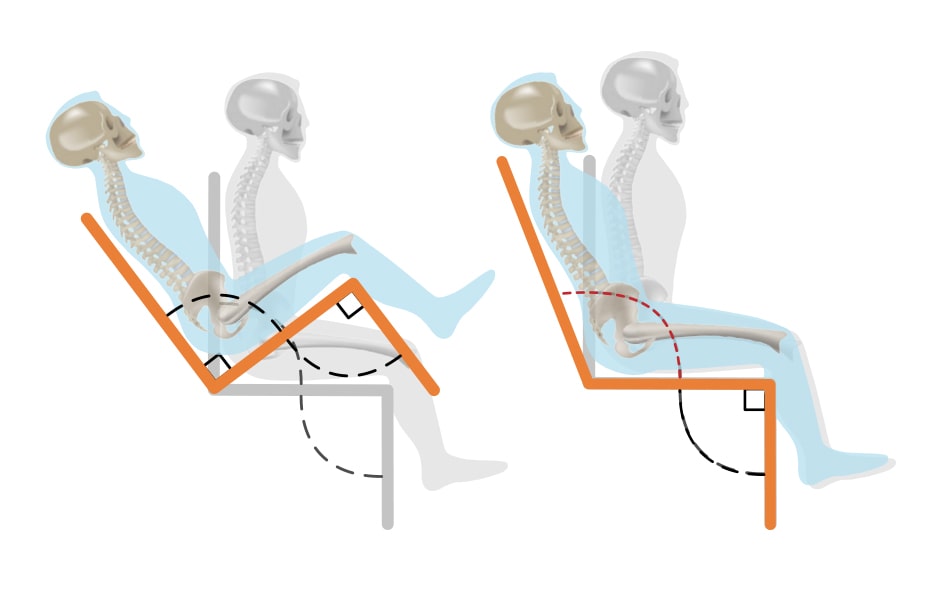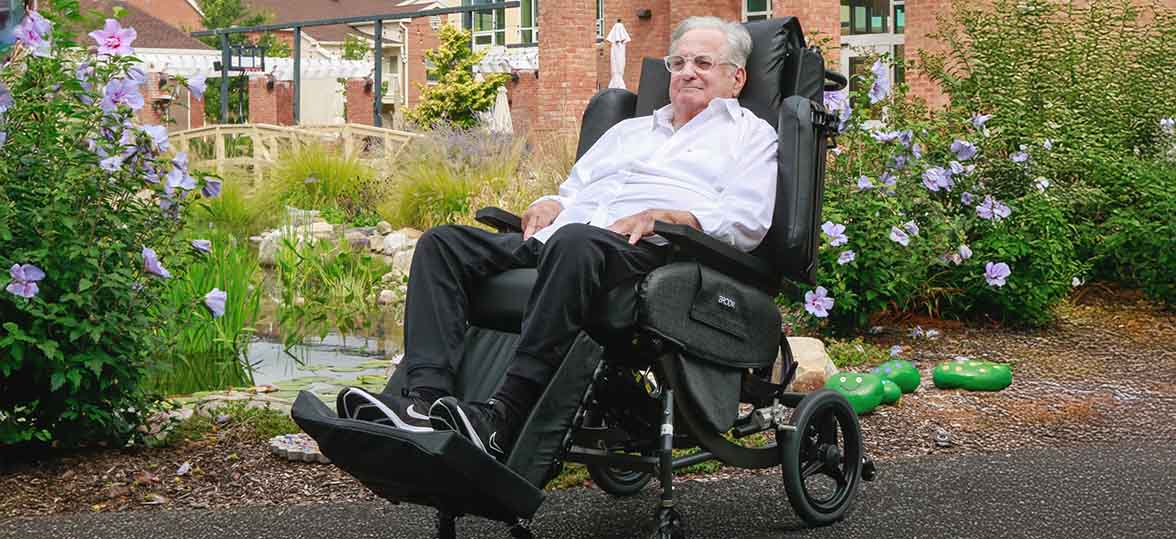When selecting positioning wheelchair options for yourself or a loved one, you’ll need to determine which elements are the most important. Both features are designed to address essential mobility needs, but they function differently and serve unique purposes.
Below, we explore the key differences between tilt vs. recline wheelchair features to help you choose the option that best supports your specific medical needs, lifestyle requirements, and daily activity goals.
Understanding Tilt vs. Recline Wheelchair Positioning
Positioning wheelchairs serve individuals who require optimal posture support, pressure relief, and comfort beyond what standard wheelchairs provide.
Positioning wheelchairs provide postural support for spinal alignment and help prevent complications from prolonged poor positioning. They also reduce associated breathing issues and digestive problems, and help with strained muscles and joints.
They are commonly used in long-term care facilities and rehabilitation centers serving individuals with fragile skin, fall risks, poor posture, spinal cord injuries, nerve and muscle conditions, and severe mobility limitations.
These specialized wheelchair features incorporate tilt-in-space and recline positioning to address medical conditions, limited mobility, and extended sitting requirements.
Tilt-In-Space
These designs tilt the entire seating system backward by as much as 40 degrees, preserving the fixed seating angle and providing a consistent backrest, seat, and leg support.
Users maintain their original posture while being reoriented in space, redistributing pressure from their pelvis to their back.
Tilting preserves the spinal alignment at every angle and allows for long-term seating comfort. Frequent repositioning in tilt is a common part of pressure injury prevention plans and fall prevention protocols.
Recline
These designs feature backrests that move backward independently, so users can transition from an upright seated position to a horizontal position. Some wheelchairs recline up to 90 degrees.
Reclining increases the angle between the hips and spine. This reduces pressure on the lower body and spreads weight more evenly, helping relieve discomfort and prevent pressure sores.
This positioning enables users to lie back for pressure relief, comfort, and medical procedures such as catheter changes or incontinence issues. Recline features also provide relief from prolonged upright positioning.

A Pitfall of Reclining Wheelchairs: Why Recline Should Always Be Accompanied by Tilt
Recline is a useful tool for wheelchair comfort, but it can cause major damage if not used in conjunction with other positioning features. Beware of reclining wheelchairs that do not also tilt. If recline is used without tilt, the person in the wheelchair is in danger of sliding down the slope of the backrest into a slouched or slumped position.
This position is called “sacral sitting” and places too much pressure on the sensitive tailbone. If a person remains in this position, they are at high risk for a pressure sore. This position is also unstable and creates a high risk for a fall.
The sliding action can be dangerous as well. When the individual slides down the backrest and their hips slide forward, the skin in contact with the seat can be pulled and stretched. This stretching can instantly cause tiny tears in the lower layers of the skin. This phenomenon is called “shear.” Shear is very painful and can cause an immediate pressure wound.
When tilt is used prior to recline, the wheelchair user’s hips remain in the proper position, preventing sliding and slouching. This maintains proper posture, prevents falls and pressure injuries, and allows the user to remain more comfortable for longer periods.
Key Differences Between Tilt and Recline Wheelchair Features
While both tilt-in-space and recline offer unique benefits for your health and comfort, they serve different positioning needs with their distinct designs.
Pressure Relief Benefits
Tilt-In-Space
A tilt system provides better pressure redistribution, tipping the whole body to shift weight away from the pelvis and thighs toward the trunk and head. When adjusting, the entire body maintains alignment.
Recline
A reclining system can lessen pressure on the sitting bones, but extra care is required when repositioning to prevent skin irritation or breakdown from shear forces during adjustment. Therefore, it’s recommended to only use these features in combination with tilt.

Posture Support
Tilt-In-Space
Tilt is beneficial for preserving spinal alignment and preventing the postural drift that can occur from a reclining model. Tilt maintains a consistent hip, knee, and ankle angle, providing stability that reduces fatigue.
Recline
Reclining allows gravity to pull the body downward by opening the hip angle. It’s important to be careful when adjusting positions to prevent sliding and skin breakdown, but when used properly along with tilt, reclining can benefit individuals who have low sitting tolerance, such as individuals with low muscle tone, tight hip flexors, or forward-flexed postures.
Choosing the Right Wheelchair Features for Your Needs
Deciding on the ideal wheelchair design for your lifestyle and physical needs is an important decision that deserves careful evaluation. We’ve created the following table to help simplify some of the broader considerations.
Daily Use Considerations
Full-time wheelchair users require maximum pressure relief and postural support, making a combination tilt and recline positioning wheelchair the preferred choice for extended sitting periods. Tilt and recline wheelchairs accommodate continuous use with regular repositioning every 30 minutes to maintain skin integrity and prevent complications.
High-risk individuals with pressure sores, spinal cord injuries, or postural instability require tilt systems for weight redistribution without shear forces and consistent alignment.
Recline systems serve users needing catheter management, medical procedure positioning, or horizontal positioning for respiratory and circulatory concerns where lying flat provides therapeutic benefits.
Lifestyle Factors
Tilt is helpful for postural control and pressure relief, while recline features are best for bed-to-wheelchair transfers or for catheters and incontinence product changes.
Front-pivot tilt-in-space shines for social independence, maintaining upright posture for theater seating and dining, and preserving eye-level contact for conversations. The addition of recline positions can help reduce injuries and the frequency of transfers, and assist individuals with resting comfortably out of bed.
Warning Signs and Custom Solutions
It’s important to choose a wheelchair that supports an individual’s unique support and positioning needs. The following are symptoms that signal a person needs more support than the standard wheelchair provides:
These may be signs of inadequate support that can lead to pressure injuries and compromised breathing if not addressed.
A hybrid positioning wheelchair may be an ideal solution, offering the combined features of recline and tilt systems. Complex positioning needs may require the versatility stemming from custom-molded cushions, contoured backrests, and modular support options.
Learn More with Broda
Choosing the right wheelchair for your lifestyle and medical needs is an important decision that directly impacts your daily quality of life. Our resources explore various medical conditions and which wheelchair positioning systems provide the best clinical benefit.
Broda provides you with the best options of hybrid positioning wheelchairs to accommodate your unique medical and lifestyle needs, including additional features like removable arm rests and shoulder bolsters that make lateral, draw-sheet transfers easier.
This ensures you can appreciate all of the health benefits of tilt-in-space adjustments while safely adding recline options best suited to your needs.




